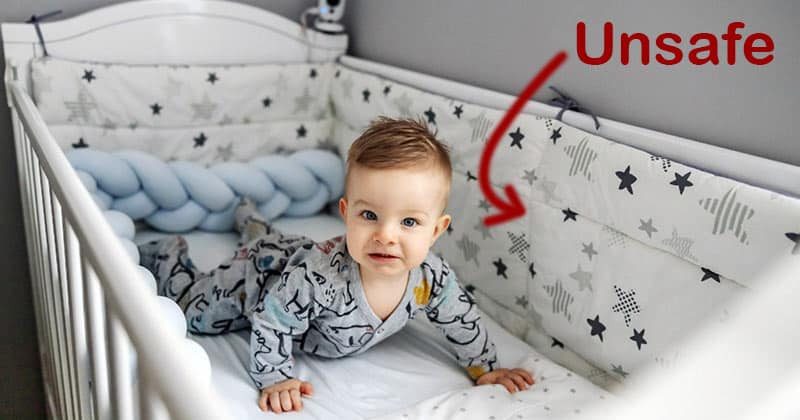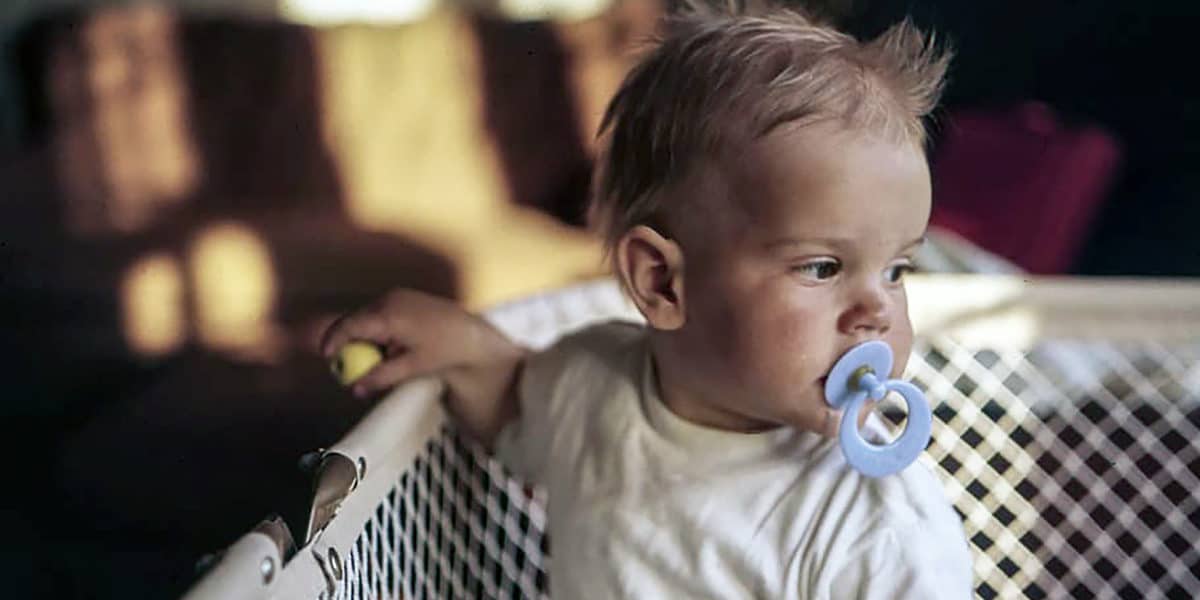Crib bumpers are not recommended for use in infants’ cribs. The American Academy of Pediatrics (AAP) recommends against using crib bumpers because they can increase the risk of suffocation, strangulation, and entrapment. For the latest advice from the AAP, see this report.
Crib Bumpers Make Little Ones Less Safe

Crib bumper pads are designed to prevent an infant’s head or limbs from getting stuck between the slats of the crib. However, they can also create a risk of suffocation. An infant’s nose and mouth can become pressed against the bumper or if the bumper covers the infant’s face.
Crib bumpers can also pose a risk of strangulation if an infant’s neck becomes caught in the ties or straps that hold the bumper in place. In addition, a crib bumper can create an entrapment hazard if an infant becomes trapped between the bumper and the side of the crib.
The safest option for infants is to use a firm, flat, and fitted crib sheet on the mattress. The crib should be kept free of any other soft bedding or objects, including pillows, quilts, and stuffed animals, to reduce the risk of SIDS (sudden infant death syndrome) and other sleep-related deaths.
What Are Crib Bumper Pads?
Crib bumper pads are long, padded pieces of fabric that are used to surround the inside of a baby’s crib.
- They are typically made of a soft, padded material such as foam or polyester fill, and are designed to protect the baby from bumping their head or limbs against the sides of the crib.
- Crib bumper pads are attached to the inside of the crib using ties or velcro, and are typically sold in sets of four to completely surround the crib.
Some people believe that crib bumper pads provide added safety for a baby by protecting them from injury, while others believe that they may pose a risk to a baby’s safety and therefore should not be used. However, the American Academy of Pediatrics advises against the use of crib bumper pads, stating that they are unnecessary and may pose a risk of suffocation or strangulation to babies.
The Problem with Crib Slats
Crib slats are the horizontal or vertical bars that make up the frame of a baby’s crib. These slats are spaced apart to allow air to circulate and to allow the caregiver to see the baby inside the crib.
While crib slats are not inherently dangerous, there is a risk that a baby could get their head or limbs stuck between the slats if they are placed too far apart. This could potentially lead to injury or even suffocation if the baby is unable to free themselves.
To reduce this risk, it is important to follow the manufacturer’s guidelines for proper assembly and use of the crib, and to make sure that the slats are spaced no more than 2 3/8 inches apart. It is also important to regularly check the crib for any loose or broken slats, and to make sure that the crib is in good repair at all times.
Alternatives to Crib Bumper Pads
There are alternatives to crib bumpers that can be used to help protect a baby from bumping their head or limbs against the sides of the crib. These alternatives include:
- Crib tents: These are mesh or netting covers that fit over the top of the crib and provide a barrier between the baby and the sides of the crib.
- Crib rail covers: These are padded covers that fit over the top and sides of the crib rails to protect the baby from chewing on or bumping against the hard rails.
- Soft, padded play yard: Instead of a traditional crib, you can use a soft, padded play yard as a safe and comfortable sleeping and play area for your baby.
- Thick, fitted crib sheets: Using thick, fitted crib sheets can help provide additional padding and protection for your baby.
It’s important to remember that the safest option for a baby to sleep in is a bare crib with a firm, tight-fitting mattress and no additional bedding or soft objects. This can help reduce the risk of suffocation and other sleep-related injuries.
Also Don’t Use Mesh Crib Bumpers
While mesh crib bumpers may seem like a safer alternative to traditional padded bumpers, they still pose a risk to a baby’s safety. Mesh bumpers may be more breathable than traditional bumpers, but they can still cause a baby to become trapped against the side of the crib or caught in the mesh material.
The American Academy of Pediatrics (AAP) advises against the use of crib bumpers of any kind, including mesh crib bumpers, as they can pose a risk of suffocation or strangulation to infants. The AAP recommends that babies be placed on their backs to sleep in a bare crib with a firm, tight-fitting mattress and no additional bedding or soft objects. This can help reduce the risk of sleep-related injuries, such as sudden infant death syndrome (SIDS).
We’ve Known Since 2016 that Crib Bumpers Cause Death
The American Academy of Pediatrics (AAP) updated their Safe Sleep Policy in 2016, cautioning parents against the use of bedding and bumpers in cribs. A very common question from parents is: If bumpers are so unsafe, why are they still sold?
Since their introduction to the market, according to the peer-review literature, crib bumpers were directly responsible for the suffocation or strangulation deaths of 77 infants. An additional 146 suffered serious injuries. Doctors, paediatric associations and government agencies have warned parents against using crib bumpers but they still remain a popular baby item.
Some manufacturers have marketed them as safety devices, claiming they prevent minor bumps and bruises an infant may get from rolling into the bars of the crib. The science has been clear for decades: the risk from a bump or bruise from crib bars is much less than that of suffocation on the bumper itself.
To date, the city of Chicago and the state of Maryland are the only jurisdictions to ban the sale of bumpers. Which brings us back to Dawn’s question: why isn’t the rest of the United States on board with a bumper ban? We turned to Scott Wolfson, Director of Communications at the United States Consumer Product Safety Commission (CPSC), who issued a strongly worded position statement, advising parents against the use of bumpers.
What does the statement mean for parents of infants?
The decision is a very strong message to parents from CPSC Chairman Elliot Kaye and three of his colleagues on the Commission to not use padded crib bumpers. If parents are currently using crib bumper pads they should stop using them immediately.
How does this most recent statement differ from the previous position of the CPSC?
Before today the CPSC has never said that padded crib bumpers are dangerous. We have long had the position that “bare is best” for babies placed to sleep in cribs. Today, after several years of examining the issue and receiving feedback from across industry, consumer safety advocates and evidence-based organizations like the AAP, we can say that the science is clear; a crib bumper is a suffocation hazard. Parents and caregivers should not use them. They have contributed to the deaths of too many children.
There have been calls to ban crib bumpers for several years, how did the CPSC become involved?
We received a petition from the Juvenile Products Manufacturers Association (JPMA) several years ago asking us to look into this issue. We docketed the petition and began our investigation. We are a regulatory agency so any decision we make has to be based on data and evidence. Our staff independently investigated the known fatalities associated with crib bumpers. We also reviewed comments from child health organizations like the AAP and Kids in Danger. After an extensive review, it was the decision of four members of the Commission that parents should not use these products.
If I’m reading the statement correctly, it seems as if this isn’t a ban on the sale of crib bumpers, similar to drop-side cribs or sleep positioners. Getting back to our reader’s question, if bumpers are unsafe, why are they still legal?
Correct, today’s statement is not a ban on or a recall of, padded crib bumpers. Part of our role is to make it easier for consumers to evaluate the safety of products. CPSC has not passed a regulation, at this time, that makes it illegal for retailers to sell these products; but, we hope companies take the right steps going forward based on the strong message being sent by the Chairman and Commissioners.
It’s a little difficult to compare why some products are still for sale and others have been banned, as each product and the associated risk is different. In the case of sleep positioners it was a little different because some manufacturers made the medical claim that they prevented SIDS, which fell under the jurisdiction of the FDA and led to a call from FDA and CPSC that they should be taken out of the marketplace.
Even without a ban, the statement is a message without equivocation: Parents should not use padded crib bumpers. They pose a clear risk of injury or death to infants.
Is there a next step to the statement? Is it possible crib bumper pads could be recalled or banned in the future?
The Commissioners recently voted to direct staff to work on federal rulemaking. I believe we’re also seeing a shift in how crib bedding is being marketed with many sets simply omitting the bumper. We need more retailers to move in that direction.
I notice the statement specifically references padded bumpers, does the statement also apply to mesh bumpers that are sometimes marketed as breathable?
The statement from the Commissioners is limited to padded crib bumpers. We did look at mesh bumpers in our investigation, but the bulk of the literature focuses on padded bumpers. There’s a lack of evidence for us to say that they are safe or unsafe right now. More research needs to be done in that area.
So for parents that currently use crib bumpers, what should they do?
Take them out of their baby’s crib immediately. Your baby’s crib should be empty except for your baby and a well-fitted mattress. There should be no pillows, blankets, stuffed animals or anything else. If it’s cold they can use a sleep sac or pajamas with feet, but no blankets. Bare is best for your baby’s sleep.

